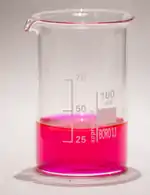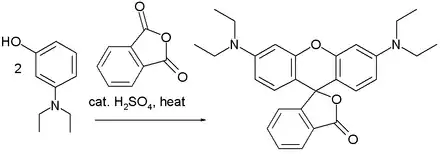Rhodamin B
Rhodamin B ist ein Xanthenfarbstoff aus der Gruppe der Rhodamine.
| Strukturformel | |||||||||||||||||||
|---|---|---|---|---|---|---|---|---|---|---|---|---|---|---|---|---|---|---|---|
 | |||||||||||||||||||
| Allgemeines | |||||||||||||||||||
| Name | Rhodamin B | ||||||||||||||||||
| Andere Namen |
| ||||||||||||||||||
| Summenformel | C28H31ClN2O3 | ||||||||||||||||||
| Kurzbeschreibung |
grünliches, geruchloses Pulver[1], in Wasser gelöst rot bis violett[2] | ||||||||||||||||||
| Externe Identifikatoren/Datenbanken | |||||||||||||||||||
| |||||||||||||||||||
| Eigenschaften | |||||||||||||||||||
| Molare Masse | 479,02 g·mol−1 | ||||||||||||||||||
| Aggregatzustand |
fest[1] | ||||||||||||||||||
| Dichte |
1,31 g·cm−3 (20 °C)[3] | ||||||||||||||||||
| Schmelzpunkt |
199–201 °C[1] | ||||||||||||||||||
| Siedepunkt |
> 245 °C (Zersetzung)[1] | ||||||||||||||||||
| Löslichkeit | |||||||||||||||||||
| Sicherheitshinweise | |||||||||||||||||||
| |||||||||||||||||||
| Toxikologische Daten | |||||||||||||||||||
| Soweit möglich und gebräuchlich, werden SI-Einheiten verwendet. Wenn nicht anders vermerkt, gelten die angegebenen Daten bei Standardbedingungen. | |||||||||||||||||||
Geschichte

Die Klasse der Rhodamine ist schon seit mindestens dem 19. Jahrhundert bekannt.[5] Rhodamin B soll zum ersten Mal 1905 synthetisiert worden sein.[6] Es ist nahe verwandt mit Rhodamin 6G, einem Laserfarbstoff, und Rhodamin WT (water-tracer), von dem es sich nur durch eine Carboxygruppe unterscheidet.
Darstellung
Rhodamin B entsteht, indem man 2 Mol 3-Diethylaminophenol mit einem Mol Phthalsäureanhydrid unter Zugabe von Schwefelsäure und Salzsäure erhitzt.[7]

Eigenschaften

Das Absorptionsmaximum von Rhodamin B liegt zwischen 542 und 554 nm.[2] Das Lumineszenzspektrum einer Lösung hängt von Faktoren, wie dem Lösungsmittel, dem pH-Wert und insbesondere der Temperatur[8] ab. Die Lumineszenz einer neutralen, wässrigen Lösung hat sein Maximum bei etwa 600 nm.
Verwendung
Rhodamin B wird in der Auramin-Rhodamin-Färbung im Labor, für Färbeversuche in der Natur und als unspezifischer Fluoreszenzmarker eingesetzt. Lösungen von Rhodamin B werden zur Demonstration von Zweiphotonenphotoakustik verwendet.[9][10]
Rhodamin B wurde und wird in vielen Ländern als Lebensmittelfarbstoff, für Kosmetika, als Textilfarbstoff und als Wasser-Tracer verwendet.[11][12][13] In den USA war die Verbindung unter der Bezeichnung D&C Red No. 19 registriert, die Zulassung als Zusatzstoff wurde jedoch 1984 von der FDA zurückgezogen.[14] Auch in Europa ist Rhodamin B nicht für die Einfärbung von Lebensmitteln oder Kosmetika zugelassen, da das Produkt als potentiell karzinogen, mutagen und ökotoxisch eingestuft wird.[15][16] Es wird dennoch als Textilfarbstoff genutzt[17] und taucht ab und an als Lebensmittelfarbstoff in Süßigkeiten,[18][19] oder in Shrimps[20][21] auf.
Weblinks
Einzelnachweise
- Datenblatt Rhodamin B (PDF) bei Carl Roth, abgerufen am 19. April 2013.
- Datenblatt Rhodamine B bei Sigma-Aldrich, abgerufen am 19. April 2013 (PDF).
- Eintrag zu Rhodamin B in der GESTIS-Stoffdatenbank des IFA, abgerufen am 3. Januar 2023. (JavaScript erforderlich)
- S. D. Gangolli: The Dictionary of Substances and their Effects (DOSE) O-S. Royal Society of Chemistry, 1999, ISBN 978-0-85404-833-5, S. 688.
- E. Noelting, K. Dziewonski: Zur Kenntniss der Rhodamine. In: Berichte der deutschen chemischen Gesellschaft. Band 38, 1905, S. 3516–3527, doi:10.1002/cber.190503803186.
- T. Nedelcev, D. Racko, I. Krupa: Preparation and characterization of a new derivative of Rhodamine B with an alkoxysilane moiety. In: Dyes and Pigments. Band 76, 2008, S. 550–556, doi:10.1016/j.dyepig.2006.11.002.
- A. Willmes: Taschenbuch Chemische Substanzen, 3. Auflage, Verlag Harri Deutsch, 2007, ISBN 978-3-8171-1787-1, S. 972.
- T. Karstens, K. Kobs: Rhodamine B and Rhodamine 101 as Reference Substances for Fluorescence Quantum Yield Measurements. In: The Journal of Physical Chemistry. Vol. 84, Nr. 14, 1980, S. 1871–1872, doi:10.1021/j100451a030 (englisch).
- Y. Yamaoka, M. Nambu, T. Takamatsu: Fine depth resolution of two-photon absorption-induced photoacoustic microscopy using low-frequency bandpass filtering. In: Optics Express. Band 19, 2011, S. 13365, doi:10.1364/OE.19.013365, PMID 21747492.
- G. Langer, K.-D. Bouchal, H. Grün, P. Burgholzer, T. Berer: Two-photon absorption-induced photoacoustic imaging of Rhodamine B dyed polyethylene spheres using a femtosecond laser. In: Optics Express. Band 21, 2013, S. 22410, doi:10.1364/OE.21.022410, PMID 24104130.
- H. Lee, S. H. Park, Y. K. Park, B. H. Kim, S. J. Kim, S. C. Jung: Rapid destruction of the rhodamine B using TiO2 photocatalyst in the liquid phase plasma. In: Chemistry Central Journal. Band 7, Nummer 1, 2013, S. 156, doi:10.1186/1752-153X-7-156, PMID 24041151, PMC 3847586 (freier Volltext).
- M. Soylak, Y. E. Unsal, E. Yilmaz, M. Tuzen: Determination of rhodamine B in soft drink, waste water and lipstick samples after solid phase extraction. In: Food and chemical toxicology : an international journal published for the British Industrial Biological Research Association. Band 49, Nummer 8, August 2011, S. 1796–1799, doi:10.1016/j.fct.2011.04.030. PMID 21570440.
- T. Kaji, T. Kawashima, M. Sakamoto, Y. Kurashige, F. Koizumi: Inhibitory effect of rhodamine B on the proliferation of human lip fibroblasts in culture. In: Toxicology. Band 68, Nummer 1, 1991, S. 11–20, doi:10.1016/0300-483X(91)90058-9; PMID 1871776.
- D&C Red No. 19. California Office of Environmental Health Hazard Assessment, abgerufen am 10. Juni 2021 (englisch).
- A. Kranjc (Hrsg.): Tracer Hydrology 97: Proceedings of the 7th International Symposium on Water Tracing. A. A. Balkema Publishers, Rotterdam 1997, ISBN 978-90-5410-875-7, S. 71–75 (eingeschränkte Vorschau in der Google-Buchsuche).
- P. Brandt: Berichte zur Lebensmittelsicherheit. Bundesamt für Verbraucherschutz und Lebensmittelsicherheit 2005, S. 8.
- Q. Wang, J. Li, Y. Bai, X. Lu, Y. Ding, S. Yin, H. Huang, H. Ma, F. Wang, B. Su: Photodegradation of textile dye Rhodamine B over a novel biopolymer-metal complex wool-Pd/CdS photocatalysts under visible light irradiation. In: Journal of Photochemistry and Photobiology. B, Biology. Band 126, September 2013, S. 47–54, doi:10.1016/j.jphotobiol.2013.07.007, PMID 23895864.
- The Daily Mail: Illegal and potentially carcinogenic food dyes normally used by the sewage industry discovered in children's sweets, 17. Februar 2014.
- Dinsa Sachan: Toxic industry dyes found in Indian sweets. In: Chemistry World. 3. April 2013, abgerufen am 20. Dezember 2023 (englisch).
- Food Safety Net: Colouring in belacan can cause cancer, 13. August 2010.
- ABS-CBN News: Industrial dye found in food in Cebu - FDA, 22. Oktober 2013.

